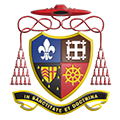1873 (Autumn)
The Franciscans opened a ‘middle class school for boys’ beneath St Francis’ Church in Crescent Grove in Stratford with 25 students.
This was called St Francis Day School and was only temporary accommodation, this closed a year later.
27 August 1877
St Bonaventure’s School in Upton was founded under the supervision of Father Germain Verleyen O.F.M and numbers began to grow rapidly.
Mr McVey was the first Headteacher under the direction of the the Franciscan fathers and the active patronage of Cardinal Henry Manning.
We were a Preparatory School and Junior School during the early days, that is why in some of the old photos on display the boys look so small and young.
1902 & 1904
As a result of the Education Acts, St Bonaventure’s became a secondary school known as West Ham Grammar School. At this time, it was a fee paying school.
1910
The initial roll of 6 boys had risen to 100 with 5 masters employed.
The First World War Years were very difficult for our school. Lots of boys were left fatherless and records of admissions at that time show ‘killed in action’ next to the father’s name and occupation category.
1920
During the 1920’s the school had 150 boys on roll and at the outbreak of war in 1939 that number increased to just over 200 with 11 teachers.
During the Second World War the school was evacuated to Felixstowe in Suffolk and was based in the county secondary school, Felixstowe Grammar, which was co-educational, whilst still retaining its own identity.
1940
The boys were billeted at the nearby villages of Trimley St Mary and Trimley St Martin, but they were not there for long as in the Spring of 1940 the German occupation of Norway and Denmark meant that Felixstowe could no longer be considered a safe town.
The school returned briefly to Forest Gate before relocating to South Wales and the Rhondda Valley at Pentre Secondary School for a brief spell. The students lived in a village called Treherbert, but arrangements were not satisfactory – there was no Catholic Church nearby (Treorchy was the closest) and travelling to the school was proving costly – and there were plans to move back to Forest Gate but the Blitz of 1940 put an end to that strategy.
A temporary home was found in Raunds – a small rural market town in Northamptonshire – but as there was no accommodation available, the students and school had to settle in Wellingborough a few villages away. Here the students alternated between the Public and the Grammar Schools. This arrangement lasted until January 1943.
This was a critical period in the history of the school since evacuation was voluntary, many boys left and numbers fell alarmingly and closure seemed inevitable. War brings uncertainty and after a period of doubt, an era of resurgence and regrowth followed.
The school motto at the time at that time was ‘Animo et Fide’ which translates as Courage and Faith.
1944
In response to the 1944 Education Act, St Bonaventure’s became a voluntary aided multilateral school, the first and arguably most successful of its kind in the country.
The school no longer existed for a small body of highly selective boys but was now open to all boys aged 11 – 14 from East London and Essex and embraced the entire ability range. The number on roll trebled at this time.
1949
In 1949 it reverted back to the name St Bonaventure’s School. The school’s frontage and address was Khedive Road which we now call St Antony’s Road.
A plaque to ‘The glory of God and the memory of the old Bonaventurians who gave their lives in the wars of 1914 – 1918 and 1939 – 1945’ was erected in St Antony of Padua to remember all those who died. Next time you are in church see if you can find it and say a prayer.

